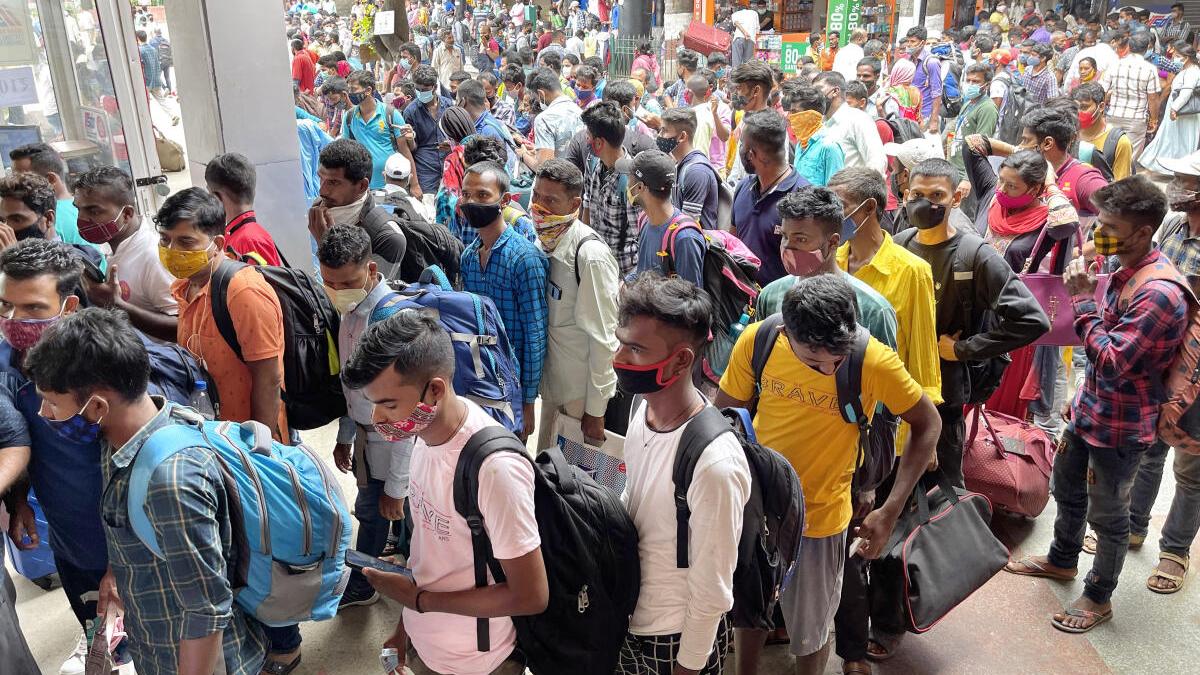Migrant workers arrive at Bengaluru city railway station from Eastern states.
The Special Intensive Revision (SIR) of the electoral rolls in Bihar has raised concerns about possible disenfranchisement of migrant voters. Bihar, along with Uttar Pradesh, is a key source of outmigrants, and people from these two States are relocating in large numbers. This mobility is visible across the country. While it was evident during the COVID-19 pandemic, there is little data to document it. The last Census was in 2011. The 2027 Census will capture these migration patterns of the last 15 years, but there are proxy data sets and recent sample surveys that give insights into where people are going and from where.

The Election Commission of India (ECI) is clear that one of the objectives of the SIR is to eliminate migrants who have relocated out of the State from Bihar’s electoral rolls. The concerns regarding migrant voting rights is misplaced, for the simple reason that they are supposed to be voters where they have migrated to — where they are ordinarily residents. The Bihar SIR is an experiment in determining whether one can vote, and where one can vote; whether one is a citizen, and where one is a resident. This experiment in both demographic accounting and engineering will have many political implications, far beyond Bihar.
Changing the demographic composition of constituencies is one way of influencing electoral outcomes. A citizen from Bihar voting in Bihar and voting in Maharashtra or Kerala will have different implications for the national political map. By enforcing the law on residency and voting, the ECI is trying to fast-track the political implication of population shifts.

People move from where there are more of them to where there are fewer; and they move from places of poor economic opportunity to places with better opportunity. Though the 2011 Census captures the direction and the quantum of this movement, the proxy data from recent years supports this — this is how we can make sense, certainly directionally, though not necessarily in absolute numbers, of where people are arriving and where they are leaving from.

The first clue comes from unreserved train travel, according to a paper by the Economic Advisory Council to the Prime Minister (EAC-PM). A regression analysis in the paper shows a strong correlation between unreserved train travel and the migrant population. Chart 1 shows the share of passengers arriving in Maharashtra in 2023 with unreserved tickets, based on their departure stations. Such travel is common between neighbouring States, as people from border districts often use this mode to cross the border with a strong possibility of returning to their homes the same day. Therefore, unreserved train travel between States that do not share a border becomes a stronger proxy for migration. About 50% of travellers with unreserved tickets originate within Maharashtra, followed by 12.3% from Gujarat and 5.4% from Karnataka — both neighbouring States (Chart 1). The two non-neighbouring States among the top five points of origin are Bihar and Uttar Pradesh, each accounting for over 7%, which clearly shows the direction of migrants from Bihar and Uttar Pradesh to Maharashtra.
Another measure is the ratio of savings account balances to current account balances. A current account, typically operated by businesses, offers features that a savings account does not. The districts with low savings-to-current account ratios are typically cities with high levels of economic activity which attract migrants. In Mumbai (0.56), Delhi (2.24), and Bengaluru (2.21), the ratio was much lower compared with the national median (3.72).

In contrast, cities with relatively higher savings-to-current account ratios are seen as having limited economic activity. For instance, many districts in Uttar Pradesh and Bihar have a higher ratio, indicating possible outmigration. Map 2 shows the district-level average ratio of savings account deposits to current account deposits from 2017-18 to 2022-23. Many southern capitals such as Chennai, Bengaluru, and Hyderabad, as well as industrial hubs such as Tiruppur and Coimbatore, stand out in blue, indicating possible in-migration.
A study by the State Planning Commission of Tamil Nadu, conducted in November–December 2024, surveyed migrant workers in Chennai and three neighbouring districts and found that 35% of them were from Bihar, 20% from Odisha and 16% from the northeast (Chart 3).
Another dataset reflecting this trend comes from an analysis of migrant labourers who returned to their home towns from Tamil Nadu in trains during the pandemic lockdown. The analysis, published on the IIM Bangalore website, shows that most (30%) passengers leaving Tamil Nadu were bound for Bihar.

These migrant populations turn permanent residents of their host States through a gradual process, but the residency rule enforcement could possibly accelerate the process. The political character and electoral dynamics respond to the changing composition of the population. In Delhi and Mumbai, migrants from the Hindi belt are now a decisive political constituency, and parties respond accordingly. In the U.S. and the U.K., politicians of Indian origin emerged on the national stage corresponding to the rise of their population in the country. Bihar SIR’s politics will ripple far beyond the borders of the State.
Source: EAC-PM and the Tamil Nadu State Planning Commission
Published – August 13, 2025 08:00 am IST
